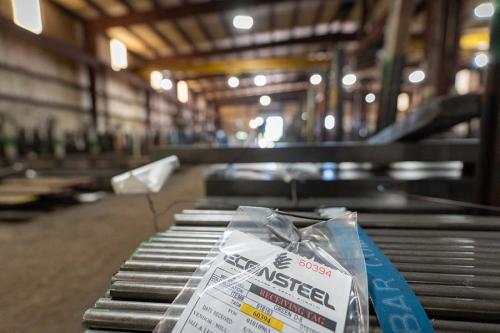Steel numbering refers to a systematic method used to identify and classify different types of steel based on their composition and properties. This system provides a standardized way to refer to steel grades, facilitating communication and ensuring consistency in the industry.
Most people are unaware that there are over 3,500 different grades of steel. You can find a steel's grade by measuring the amount of carbon in the steel, its other alloys, and how the manufacturer processes it. Steel is graded and categorized into four groups; Carbon, Alloys, Stainless, and Tool. Steel Grading systems help differentiate types of steel based on properties and their different uses.
How is Steel Graded?
Steel grading is a meticulous process that involves categorizing steel based on its chemical composition, mechanical properties, and specific uses. The most widely recognized grading systems include those established by the American Society for Testing and Materials (ASTM), the American Iron and Steel Institute (AISI), and the Society of Automotive Engineers (SAE). These organizations use distinct numbering systems and criteria to classify steel.
For instance, ASTM standards typically use a combination of letters and numbers to denote different types of steel, such as ASTM A36, which signifies a common structural steel grade. AISI and SAE often employ a four-digit code where the first two digits represent the primary alloying elements and the last two indicate the carbon content.
The grading process begins with a detailed analysis of the steel's chemical composition, measuring elements like carbon, manganese, chromium, and nickel. This is followed by testing the steel's mechanical properties, including tensile strength, yield strength, hardness, and ductility. Advanced techniques such as spectroscopy and mechanical testing machines are employed to gather precise data. Once the chemical and mechanical properties are assessed, the steel is compared against established criteria for specific grades. Additional factors, such as the steel's microstructure and heat treatment history, may also influence its classification. By adhering to these stringent grading protocols, manufacturers can ensure that the steel meets the necessary standards for its intended application, whether in construction, automotive, aerospace, or other sectors.
How the ASTM Steel Grading System Works
The American Society for Testing and Materials (ASTM) grading system consists of around 12,000 different codes that classify various metal grades on the market. It assigns each metal a letter or prefix based on category ("A" is the designated letter for iron and steel). Each metal is also assigned a corresponding number that represents the specific properties of that metal.
ASTM steel grades refer to specific standards established by the American Society for Testing and Materials (ASTM), which ensure the quality and consistency of steel products. These standards classify steel based on its chemical composition, mechanical properties, and applications.
For example each grade: is designed to meet the specific requirements of different industrial applications
- ASTM A36 steel is a common structural steel grade used in construction, known for its excellent weldability and strength.
- A572 for high-strength low-alloy steel
- A514 for high-yield strength
- A351 is the standard specification for austenitic steel castings.
So, if a customer would like their steel to be cast, you would refer to this specific ASTM standard. The ASTM is responsible for setting product development and manufacturing standards across all industries. These classifications help manufacturers, engineers, and builders select the appropriate type of steel for their projects, ensuring safety, performance, and compliance with industry regulations.
AISI/SAE Standards for Steel Grading
The American Iron and Steel Institute (AISI)/Society of Automotive Engineers (SAE) is another steel grading system. It differs from the ASTM numbers in the sense that it exclusively covers product standards while only considering steel and iron.
Alloy steels and carbon steels are assigned specific grades through a four-digit AISI/SAE numerical index system. The first two digits indicate whether the material is plain carbon steel or if it may contain alloying elements. The last two digits indicate what percentage of the steel is made up of carbon.
For example, let's look at AISI/SAE No.1020: the first digit (1) indicates that this is plain carbon steel, the second digit (0) means there are no alloying elements, and the last two numbers (20) shows that that steel contains about 0.20 percent carbon, classifying it as a low-carbon (or mild) steel.
AISI Numbering System
The AISI numbering system is a widely used method for classifying various types of steel based on their chemical composition and alloying elements. This system primarily uses a four-digit code to identify different steel grades. The first two digits in this code denote the primary alloying elements that characterize the steel, while the last two digits represent the carbon content in hundredths of a percent. For instance, in the designation AISI 1045, the "10" indicates a plain carbon steel, and the "45" signifies a carbon content of 0.45%. This straightforward yet effective numbering system allows for quick identification and comparison of steel grades, ensuring that the appropriate type of steel is used for specific applications.
In addition to plain carbon steels, the AISI numbering system also covers various alloy steels by assigning different initial digits. For example, steels beginning with "13" are manganese steels, those starting with "41" are chromium-molybdenum steels, and those starting with "43" are nickel-chromium-molybdenum steels. Each category includes numerous subgrades that further specify the material's properties based on its precise chemical makeup. This classification helps manufacturers, engineers, and designers select the correct steel for their needs, facilitating efficient production and ensuring the performance and safety of the final products. The AISI numbering system's simplicity and comprehensiveness have made it a cornerstone in the steel industry, promoting standardization and interoperability across various sectors.
Understanding Steel Grading
Steel grading standards are fundamental and used in various fields, including science, architecture, engineering, and even in some government agencies. They provide standard terms to ensure the properties and specifications of steel and steel alloys are aligned throughout all industries while providing standard processing and application procedures for all manufacturers.

